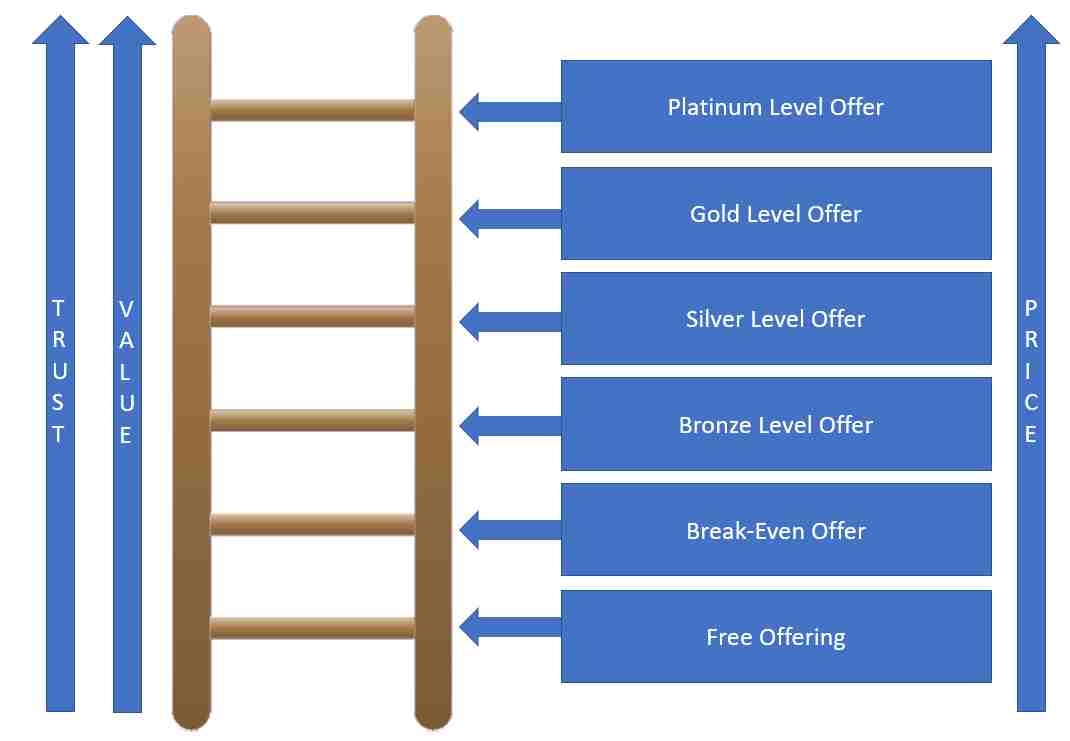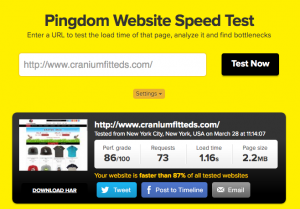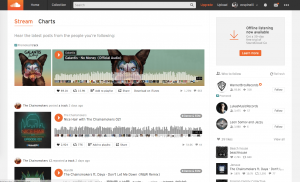
A value ladder is simply a sequence of offers that increase in price and value. They are used to build trust and maximize the lifetime value of each customer.
Allow me to share with you a concrete example of the value ladder concept. My son works at a tire store. Of course, they do a lot more than just sell tires. At the entrance, they have banners saying that they offer free tire rotation.
You have certainly experienced this before. You know that to make sure you get the most out of your tire investment, you need to rotate them regularly, so you decide to take them up on their free offer.
Once you arrive there, they offer you a free vehicle inspection since they already have your car on the rack. You agree, after all, it is free, what do you have to lose?
As you wait, the service writer calls you to the desk and tells you that the technician recommends that you replace your windshield wipers. Since you just got something for nothing, the business has made what I call a network deposit into your account. As a culture, we believe in reciprocity, so you now have a small sense of obligation to repay the company with some business. Wipers are pretty cheap so you decide to take their advice and buy a new set of windshield wipers.
As you get ready to pay for your new wipers, the service writer reviews the rest of your inspection report and tells you that the technician noted a small leak from your power steering pump. Nothing immediately critical he adds, and shares that they topped off your power steering fluid for free (another micro-network deposit) but recommends that you consider scheduling a follow-up appointment to get the pump replaced.
Welcome to the value ladder.
What is a Value Ladder?
A value ladder takes a prospect from an often free offering to your highest-priced product or service through a series of rungs on the ladder. Each rung provides an increased level of value and monetary commitment from the customer as you earn their trust.
Most businesses look to make money too early in the sales cycle and make the sale before the customer has gained any trust in the business. As a result, the business scares away the customer before they really get to know them. Contrary to the profit-first model, the primary focus of businesses should be to “attract and keep customers” to create lifetime value. The results of putting the customer first will translate into profit.
Too often I see a company pay a bunch of money on advertising only to drive the prospect to a product page to make a sale for a high-priced product or service. The result is a huge bounce rate because the customer has not yet determined the value of your offering and if your business is even trustworthy.
When executed properly, the value ladder builds trust with each successive rung on the ladder, and ultimately, inspires brand loyalty from your customers, creating a higher lifetime value for the customer.
Few prospects are willing to buy your most expensive offering out of the gate. Just as a guy would never walk into a singles bar and start proposing marriage to every woman, the same applies to business.
If you were on the hunt for a new lover in a singles bar, you might start by offering to buy a girl a drink. The acceptance of the free drink is the first micro commitment. This free drink creates a network deposit where you now bought the time it takes to drink the cocktail to move her up your value ladder. Perhaps the next rung is a dance that might lead to a phone number and then to a first dinner date. Each step has a higher commitment level as trust between the couple increases.
Most customers will become aware that your business offers a product or service they have some interest in. Unless your brand has a great reputation in your industry that the customer is aware of, it is unlikely that the customer is ready to buy from you at this point. Rather than ask the customer to trust you and leadoff trying to sell them one of your higher-priced offerings right away, think of this first interaction as a way to demonstrate to the customer that your motive is not to make money at their expense but to show them that you are trustworthy and have their best interests in mind. Start instead by giving the customer something of great value to demonstrate you care about them.
Then, to build up trust and loyalty with customers and create a greater lifetime customer value, you need to have a series of product or service offerings, each building upon the last.

Generally, most value ladders start with something for free to build an initial network deposit and create goodwill. Some common free offerings include downloadable check sheets or eBooks. While it is technically a free offering, it is not entirely free to the customer since you will want to capture their contact information.
That is often followed by another offer of something for nearly nothing, but with a minimal cost to you and high value to the customer. Generally, I recommend that the second rung be something that involves a micro-cash commitment that you can offer at a break-even cost. For example, you might offer a free product such as a paperback book if the prospect agrees to pay for shipping and handling. By the way, “handling” is kind of a nebulous term and the handling fee could be the cost of ordering and printing an author’s copy of your paperback book. As the customer progresses up the ladder, the value and price of the succeeding offerings increase, coinciding with the increased level of trust that the customer has gained in your business from each of the previous transactions. And so on, up your value ladder the customer goes. Your top-end product or service is only limited by your imagination.
Along the way, your job is to provide increasing levels of value to continue to earn the prospects’ trust and facilitate their decision to move up to the next rung on your value ladder.
Continuity Programs
Most businesses should also consider some form of continuity program as part of their value ladder to make sure that the customer, once part of your value ladder, is encouraged to stay on your ladder.
My daughter-in-law works at a dental practice that offers monthly memberships to self-insured patients as a way of giving them several teeth cleaning visits in a year as part of the membership program. Not only does the membership program provide a consistent source of revenue for the practice, but it also guarantees that the customer will return again and again to make full use of their membership. However, the real value is that it also gives the dentist many opportunities to encourage the customer to move up the value ladder.
The practice initially offers free teeth cleaning to new patients to get them in the door. That might be followed by a low-cost upsell like a teeth whitening product. As the patient pays for the teeth whitening product, the receptionist explains that most people choose to join their membership program to maintain healthy teeth. Since this is a rather significant saving compared to numerous a la carte visits, many customers agree to sign up for the program. During follow-up visits, the dentist might recommend a service that is not covered by the basic membership program such as a deep cleaning. Over time, as the business has earned the trust of the customer, the customer is far more likely to purchase some of the more expensive restorative or cosmetic dental surgeries.
Of course, not every prospect will make it to your highest-priced product or service, but by defining and utilizing a value ladder, the upselling path becomes clear and the business can extract the maximum value from the customer.
Offerings
I can hear some of you say that I only sell one product or offer one service. To that, I say – get creative. As I shared in An Unbelievably Simple and Overlooked Strategy to Crush Your Market, if you offer a Do-It-For-Me service like a lawn care business, consider a few Do-It-Yourself options like a lawn care guide or offer to service the prospect’s mower or trimmer for a fee that is a rung or two below your primary lawn caring offer. Going up a rung or two, for example, you may partner with a landscaping company to do a complete yard makeover. Be creative.
When you implement a value ladder, you are always looking for the opportunity to upsell once you have earned the trust of the customer. Only offering a single eBook for sale? Before they leave your sales page, offer a bundle that includes the eBook plus something else, like a discounted one-on-one counseling session.
How can you employ a value ladder in your business?
Business & Finance Articles on Business 2 Community
(47)









